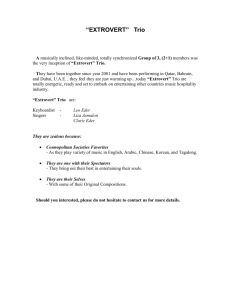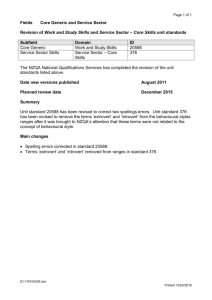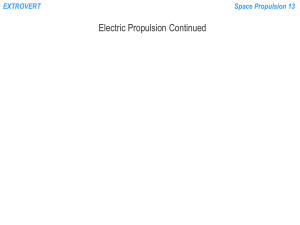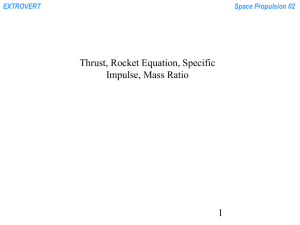spaceprop14.html
advertisement
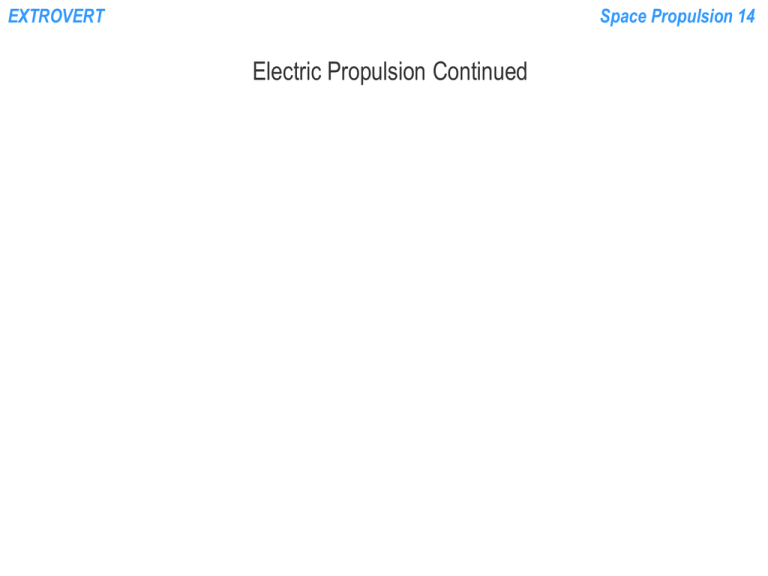
EXTROVERT Space Propulsion 14 Electric Propulsion Continued EXTROVERT Space Propulsion 14 Nuclear Rocket Engines EXTROVERT Space Propulsion 14 Nuclear Rocket Engines •Nuclear Thermal Rockets : Propellant gets heated by conduction/ convection from fuel. •Nuclear Electric Propulsion: Electric power generated by heat engine or thermo-electric effects is used to drive electric Propulsion system. •Specific Impulse more than twice that of chemical - AND •Large-thrust possible because of high thrust/weight ratio. Shorter mission times: Proponents point out that for long-duration space missions, this leads to LOWER total radiation exposure per mission. (Less time exposed to the Big Nuclear Furnaces in the Sky) EXTROVERT Space Propulsion 14 Nuclear Thermal Rockets (NTR) Originally researched by the U.S. Air Force and NASA from the late 1940s to the 1960s, the use of nuclear energy to power a rocket engine has many advantages: •High thrust (as much as chemical rockets – temperature and pressure limits are similar) •High Specific Impulse •Multiple re-starts Disadvantages: •Heavy (reactor and shielding ) •Radiation concerns •Testing / development / political issues “Thermal” reactor: neutrons slowed down below 1eV, moderator of light elements used. “Fast”: broad spectrum of neutron energy up to 15eV. No moderator. EXTROVERT Space Propulsion 14 NTR Concept Neutron Reflector: typically Beryllium shield Propellant: H2 (high Ue), CH4 (better storage density) etc. EXTROVERT Space Propulsion 14 Types of Reactors 1. NERVA (Nuclear Engine for Rocket Vehicle Applications ) Graphite fuel rods with uranium-carbide fuel particles – coated to protect from hydrogen. Coolant passes through channels in the rods. Most fully developed, but low T/W EXTROVERT Space Propulsion 14 NERVA EXTROVERT Particle Bed Reactor (PBR) Space Propulsion 14 Particles of uranium-carbide fuel (coated) are packed between two porous cylinders. Hydrogen (or helium) is directly used to cool them. PBRs have a higher fuel density and thus higher T/W. The configuration also allows a higher temperature in the working fluid before the fuel melts – Thus higher specific impulse. inisjp.tokai.jaeri.go.jp/ ACT95E/11/1104.htm EXTROVERT Space Propulsion 14 “The technical risks of the PBR include: + Challenges in fabricating the high temperature fuel particles that are the key to this technology -- efforts to date have failed to conclusively demonstrate that fuel particles can withstand the rigors of the reactor operating environment; + The low thermal capacity of the reactor core increases the risk of thermal damage to the core in off-normal conditions, or during reactor cool-down;” lifesci3.arc.nasa.gov/.../thomas/ Adv.prop/advprop.html EXTROVERT Space Propulsion 14 CERMET-core Source: www.ms.ornl.gov/.../ SCG/programs/OTT_HVPSM.html •“Cermets: composite materials made by combining a ceramic and a metallic alloy.” •“Cermets are made by 1) milling together powders of the desired materials, and 2) forming a shape, and then 3) sintering (heating) those materials together to form dense parts. The sintering process causes the component materials to bond together to form a new material with structural characteristics that are better suited for the intended use than either of the starting materials.” •CERMET fuel: Hexagonal fuel elements. Uranium oxide particles imbedded in tungsten / tungsten-rhenium matrix; uranium oxide in molybdenum. • Advantage: very long life ( > 40 hours). • Uses fast fissioning reactor that does not depend as much on a “moderator” material to slow down the neutrons in the fission reaction. •A newer system that still requires development •Has potential for multiple restarts (very robust fuel elements) EXTROVERT Space Propulsion 14 “ 6 - Cermet Reactor ( http://lifesci3.arc.nasa.gov/.../thomas/ Adv.prop/advprop.html ) General Electric (GE) is the leading proponent for the Cermet Reactor, which has been evaluated for SDI(16) and SEI applications.(17) .. advantages : + .. improved thermal conductivity compared to metal oxide fuel elements. + .. extensive fuel test engineering heritage exists from the ANP and 710 programs. + … high retention of fission products in the fuel matrix. .. experimentally demonstrated in the 710 Program, in which most test fuel elements demonstrated fission gas fraction release of less than 10-9, while some fuel elements released fission fragment fractions in the range of 10-5 to 10-4. This should produce less stringent containment and confinement restrictions on Ground Test Facilities. + .. cermet fuel may offer improved swelling behavior, but this remains uncertain. EXTROVERT Space Propulsion 14 Several issues remain open: - .. lower fuel density relative to metal fuel elements, a potential disadvantage of cermet fuels is large core size, and thus greater core and shielding mass. - In order to improve weldability, Rhenium is a potential Cermet cladding material. “ EXTROVERT Space Propulsion 14 Reactor Comparison: Table 8.2, Humble Nerva Particle-Bed CERMET Power (MW) 1570 1945 2000 Thrust (N) 334,061 333,617 445,267 Propellant H2 H2 H2 Fuel element Solid rod Porous particle bed Solid rod Max temp (K) 2361 3200 2507 Isp (s) 825 971 930 Chamber pressure (Mpa) 3.102 6.893 4.136 Nozzle expansion ratio 100 125 120 Engine mass(Kg) 10138 1705 9091 Total shield mass(Kg) 1590 1590 1590 EXTROVERT Space Propulsion 14 Candidate Working Fluids Working Fluids: coolant, exhaust gases As the propellant, we want something that can be easily heated and results in a high Isp. Low molecular weight is preferred, but propellants with higher molecular weight may be used depending on storage volume constraints. Hydrogen: MW = 2.016 Methane: 16.043 Carbon dioxide 44.01 Water: 18.015 Note: the above offer the possibility of replenishing propellant from extraterrestrial sites. EXTROVERT Space Propulsion 14 For a given temperature limit, we can determine the specific heats from equations or tables and find the other quantities such as : cp , c *,CF ,Isp cp cp cv c p R c Runiv p Mol .Wt Runiv 8314J /(kmol K ) EXTROVERT Space Propulsion 14 NTR Performance Example Assume a PBR NTR. Hydrogen is heated to 3000K at a total pressure of 60 atm The engine operates in vacuum with e = 200, At = 100 cm2, hCF = 0.97, hC* = 1.0. Find vacuum specific impulse, thrust and mass flow rate of hydrogen. At 3000K, 1 T cp 56.05 702.74 100 2.016 0.75 kJ 1165 18.048 kgK T 100 EXTROVERT Space Propulsion 14 This gives 1.289 c* c * RTc 1 1 2 1 5287m / s EXTROVERT Space Propulsion 14 Pe 0.000172 P0 At = 200, =1.289, cFideal cFideal 1 2 1 2 1 1.874 2 1 1 Pe 1 Pc Pe c Pc EXTROVERT Space Propulsion 14 cF cF cFideal 1.8178 Ispv c * cF 979.7 sec g0 Tvac 110,520N mp 11.5kg / s Not counting any turbine/pump losses (I.e., closed cycle) EXTROVERT Space Propulsion 14 Reactor Power The reactor provides the power necessary to heat the propellant to the required temperature. Pcore hv Psp 60 T2 mp hv c pdT mpPsp T1 Heat of vaporization Specific power required. Depends on propellant initial / final temperatures H2 is 48 MW/(kg/s) For H2 at 3000K, P sp CH4 Psp CO2 0 2000 T 3500 Pcore 552MW EXTROVERT Space Propulsion 14 Reactor Mass From Fig. 8.21 in Humble, (Reactor Mass vs. Reactor Power for different NTR technologies ) the mass of the reactor is estimated as 500 kg. EXTROVERT Space Propulsion 14 Reactor Shielding We also typically provide a “shadow shield” between the reactor and the payload for in-space applications. A typical shield consists of layers of Lithium hydride (LiH2) which is a neutron absorber, Tungsten to shield against gamma rays, Beryllium as a neutron reflector. A typical shield may be 25cm thick and have a mass-density of 3500 kg/m2 of surface area Total mass = Reactor + shield + nozzle + turbopumps + core containment vessel Typical thrust-to-weight ratio of an NTR is from 3 to 10. EXTROVERT Preliminary Design Decisions Space Propulsion 14 NERVA type core limited to ~ 2360 K temperature CERMET: 2500K PBR: 3200K Determine gas properties Determine Nozzle expansion ratio and Isp. Sizing the System Inert-Mass Fraction (when using hydrogen propellant): 0.5 to 0.7 Lack of database of nuclear engines prevents good estimate of inert mass fraction: iterate. From Isp and required thrust, find propellant mass flow rate. Determine required reactor power to heat propellant to required temperature at the required flow rate. EXTROVERT Space Propulsion 14 Determine system pressure levels: empirical correlations NERVA-1 Enhanced Particle NERVA Bed CERMET Chamber Pressure 3.1 MPa 6.9MPa 6.2MPa 4.1MPa Core pressure drop: % of chamber pressure 38% 10.6% 5% 53.7% % of reactor head pressure 27.5% 9.6% 4.8% 34.9% EXTROVERT Space Propulsion 14 Prometheus Nuclear Engine: JIMO mission Jupiter Icy Moons Orbiter: Nuclear electric primary propulsion Two basic types of technology under consideration: (1) radioisotope-based systems (2) nuclear fission-based systems. EXTROVERT Space Propulsion 14 RadioIsotope Thermoelectric Generators Heat from plutonium dioxide and solid-state thermocouples to convert directly to electricity. Cold outer space is the cold junction. General Purpose Heat Generator: 250 watts Multimission Radioisotope Thermoelectric Generator: 100watts, 14+ years http://spacescience.nasa.gov/missions/MMRTG.pdf EXTROVERT Space Propulsion 14 Stirling Radioisotope Generator http://spacescience.nasa.gov/missions/Stirling.pdf Closed cycle Stirling cycle free-piston machine. Heat from GPHG with 600g Plutonium dioxide at 650C. Heat rejected from other end at 80C. Closed-cycle Engine converts heat to reciprocating motion – linear alternator produces 62-65 watts AC – converts to 55w DC.

